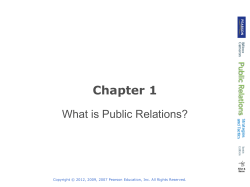
Chapter 22 Current and Resistance
Chapter 22 Current and Resistance The image cannot be displayed. Your computer may not have enough memory to open the image, or the image may have been corrupted. Restart your computer, and then open the file again. If the red x still appears, you may have to delete the image and then insert it again. Topics: • Current • Conservation of current • Batteries • Resistance and resistivity • Simple circuits Sample question: How can the measurement of an electric current passed through a person s body allow a determination of the percentage body fat? Copyright © 2007, Pearson Education, Inc., Publishing as Pearson Addison-Wesley. Slide 22-1 Series and Parallel Series • Circuit elements in a chain between 2 points • Same current flows through circuit elements I1 = I2 • Electric Potentials add => Delta Vtotal = Delta V1 + Delta V2 Parallel • Circuit elements on multiple paths connecting the same points • Since paths connect the same points, Delta V s are the same • Currents Add => Itotal = I1 + I2 Copyright © 2007, Pearson Education, Inc., Publishing as Pearson Addison-Wesley. Slide 22-25 QuickCheck The battery current I is A. 3 A B. 2 A C. 1 A D. 2/3 A E. 1/2 A Copyright © 2007, Pearson Education, Inc., Publishing as Pearson Addison-Wesley. QuickCheck The battery current I is A. 3 A B. 2 A C. 1 A D. 2/3 A E. 1/2 A Copyright © 2007, Pearson Education, Inc., Publishing as Pearson Addison-Wesley. QuickCheck The diagram below shows a circuit with two batteries and three resistors. What is the potential difference across the 200 Ω resistor? A. 2.0 V B. 3.0 V C. 4.5 V D. 7.5 V E. There is not enough information to decide. Copyright © 2007, Pearson Education, Inc., Publishing as Pearson Addison-Wesley. QuickCheck The diagram below shows a circuit with two batteries and three resistors. What is the potential difference across the 200 Ω resistor? A. 2.0 V B. 3.0 V C. 4.5 V D. 7.5 V E. There is not enough information to decide. Copyright © 2007, Pearson Education, Inc., Publishing as Pearson Addison-Wesley. • The current through the 3 ! resistor is QuickCheck 23.7 • 9 A • 6 A • 5 A • 3 A • 1 A © 2015 Copyright © 2007, Pearson Education, Inc., Publishing as Pearson Addison-Wesley. • The current through the 3 ! resistor is QuickCheck 23.7 • 9 A • 6 A • 5 A • 3 A • 1 A © 2015 Copyright © 2007, Pearson Education, Inc., Publishing as Pearson Addison-Wesley. Why is one bulb Brighter, 40 W vs. 100 W Why is one bulb brighter? Which has the greatest resistance? In parallel, which carries the greatest current? Voltage Divider Copyright © 2007, Pearson Education, Inc., Publishing as Pearson Addison-Wesley. Slide 22-35 Kirchhoff s Laws Copyright © 2007, Pearson Education, Inc., Publishing as Pearson Addison-Wesley. Slide 23-11 Series and Parallel Circuits • There are two possible ways that you can connect the circuit. • Series and parallel circuits have very different properties. • We say two bulbs are connected in series if they are connected directly to each other with no junction in between. Copyright © 2007, Pearson Education, Inc., Publishing as Pearson Addison-Wesley. Calculating Equivalent Resistance Copyright © 2007, Pearson Education, Inc., Publishing as Pearson Addison-Wesley. Slide 22-35 Example Problem A resistor connected to a power supply works as a heater. Which of the following two circuits will provide more power? Copyright © 2007, Pearson Education, Inc., Publishing as Pearson Addison-Wesley. Equivalent Resistance Examples 1. By using only two resistors singly, in series, or in parallel you are able to obtain resistances of 18.0, 24.0, 72, and 96 . What are the two resistances? (Make sure your answer is consistent.) 2. Find the equivalent resistance of the following circuit: Be sure to show each step. 3. Find the heat energy generated by the 3 Ohm and the 12 Ohm resistors in the circuit in problem 2 Copyright © 2007, Pearson Education, Inc., Publishing as Pearson Addison-Wesley. Slide 22-35 Circuit Analysis with Equivalent Resistance For the following circuit, calculate the equivalent resistance for this system of resistors: Now find the Equivalent resistance for this system for the following case: R1 = R2 = R3= R4 = R5 = 10 Ohms Find Delta V, I, and Power dissipated by R1 Copyright © 2007, Pearson Education, Inc., Publishing as Pearson Addison-Wesley. Slide 22-35 QuickCheck 23.13 The battery current I is • 3 A • 2 A • 1 A • 2/3 A • 1/2 A Copyright © 2007, Pearson Education, Inc., Publishing as Pearson Addison-Wesley. QuickCheck 23.13 The battery current I is • 3 A • 2 A • 1 A • 2/3 A • 1/2 A Copyright © 2007, Pearson Education, Inc., Publishing as Pearson Addison-Wesley. QuickCheck 23.5 • Which is the correct circuit diagram for the circuit shown? Copyright © 2007, Pearson Education, Inc., Publishing as Pearson Addison-Wesley. QuickCheck 23.5 • Which is the correct circuit diagram for the circuit shown? A Copyright © 2007, Pearson Education, Inc., Publishing as Pearson Addison-Wesley. Circuit Analysis using Kirchoff’s rules (Loop + Junction) Copyright © 2007, Pearson Education, Inc., Publishing as Pearson Addison-Wesley. Slide 23-11 Circuit Analysis using Kirchoff’s rules (Loop + Junction) Circuit from End of Circuit Activity 1 Copyright © 2007, Pearson Education, Inc., Publishing as Pearson Addison-Wesley. Slide 22-35 Circuit Analysis using Kirchoff’s rules (Loop + Junction) Copyright © 2007, Pearson Education, Inc., Publishing as Pearson Addison-Wesley. Slide 22-35 Capacitors in Parallel and Series • Parallel or series capacitors can be represented by a single equivalent capacitance. Copyright © 2007, Pearson Education, Inc., Publishing as Pearson Addison-Wesley. Capacitor Combinations Copyright © 2007, Pearson Education, Inc., Publishing as Pearson Addison-Wesley. Slide 19-24 QuickCheck • Which of the following combinations of capacitors has the highest capacitance? Copyright © 2007, Pearson Education, Inc., Publishing as Pearson Addison-Wesley. Equivalent Capacitance ! = RC Copyright © 2007, Pearson Education, Inc., Publishing as Pearson Addison-Wesley. Slide 23-29 RC Circuits • RC circuits are circuits containing resistors and capacitors. • In RC circuits, the current varies with time. • The values of the resistance and the capacitance in an RC circuit determine the time it takes the capacitor to charge or discharge. Copyright © 2007, Pearson Education, Inc., Publishing as Pearson Addison-Wesley. RC Circuit Demonstrations Copyright © 2007, Pearson Education, Inc., Publishing as Pearson Addison-Wesley. RC Circuits The figure shows an RC circuit consisting of a charged capacitor, an open switch, and a resistor before the switch closes. The switch will close at t = 0. Copyright © 2007, Pearson Education, Inc., Publishing as Pearson Addison-Wesley. RC Circuits Copyright © 2007, Pearson Education, Inc., Publishing as Pearson Addison-Wesley. RC Circuits • The initial potential difference is (ΔV ) = Q /C. • The initial current—the initial rate at which the C 0 capacitor begins to discharge—is Copyright © 2007, Pearson Education, Inc., Publishing as Pearson Addison-Wesley. 0 RC Circuits Copyright © 2007, Pearson Education, Inc., Publishing as Pearson Addison-Wesley. RC Circuits • After some time, both the charge on the capacitor (and thus the potential difference) and the current in the circuit have decreased. • When the capacitor voltage has decreased to ΔV , the current has decreased to C • The current and the voltage decrease until the capacitor is fully discharged and the current is zero. Copyright © 2007, Pearson Education, Inc., Publishing as Pearson Addison-Wesley. RC Circuits • The current and the capacitor voltage decay to zero after the switch closes, but not linearly. Copyright © 2007, Pearson Education, Inc., Publishing as Pearson Addison-Wesley. RC Circuits The decays of the voltage and the current are exponential decays: Copyright © 2007, Pearson Education, Inc., Publishing as Pearson Addison-Wesley. RC Circuits • The current and voltage in a circuit do not drop to zero after one time constant. Each increase in time by one time constant causes the voltage and current to decrease by a factor of e−1 = 0.37. Copyright © 2007, Pearson Education, Inc., Publishing as Pearson Addison-Wesley. RC Circuits Copyright © 2007, Pearson Education, Inc., Publishing as Pearson Addison-Wesley. RC Circuits • The time constant has the form τ = RC. • A large resistance opposes the flow of charge, so increasing R increases the decay time. • A larger capacitance stores more charge, so increasing C also increases the decay time. Copyright © 2007, Pearson Education, Inc., Publishing as Pearson Addison-Wesley. QuickCheck • The following circuits contain capacitors that are charged to 5.0 V. All of the switches are closed at the same time. After 1 second has passed, which capacitor is charged to the highest voltage? Copyright © 2007, Pearson Education, Inc., Publishing as Pearson Addison-Wesley. Charging a Capacitor • In a circuit that charges a capacitor, once the switch is closed, the potential difference of the battery causes a current in the circuit, and the capacitor begins to charge. • As the capacitor charges, it develops a potential difference that opposes the current, so the current decreases, and so does the rate of charging. • The capacitor charges until ΔV C Copyright © 2007, Pearson Education, Inc., Publishing as Pearson Addison-Wesley. = ℇ. Charging a Capacitor • The equations that describe the capacitor voltage and the current as a function of time are Copyright © 2007, Pearson Education, Inc., Publishing as Pearson Addison-Wesley. QuickCheck 23.26 • The red curve shows how the capacitor charges after the switch is closed at t = 0. Which curve shows the capacitor charging if B the value of the resistor is reduced? Smaller time constant. Same ultimate amount of charge. © 2015 Copyright © 2007, Pearson Education, Inc., Publishing as Pearson Addison-Wesley.
© Copyright 2025









